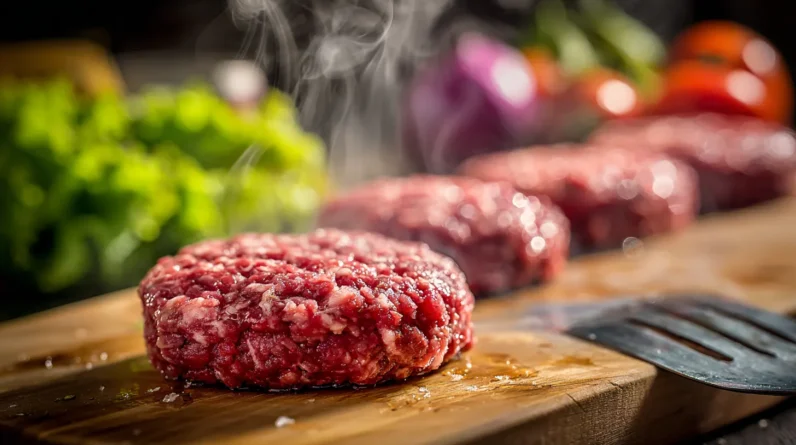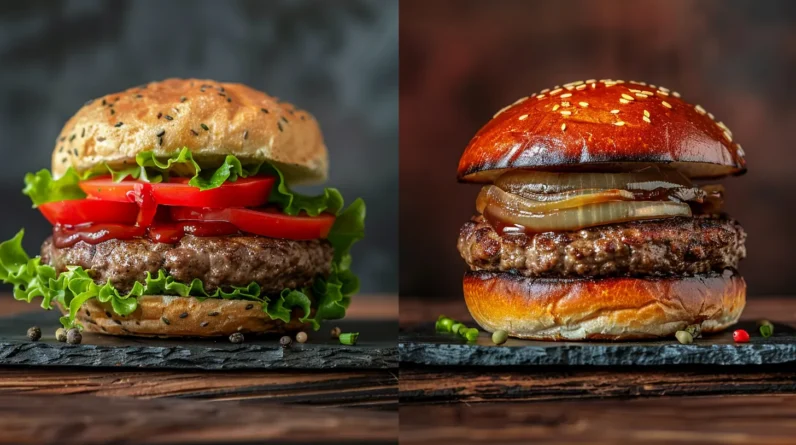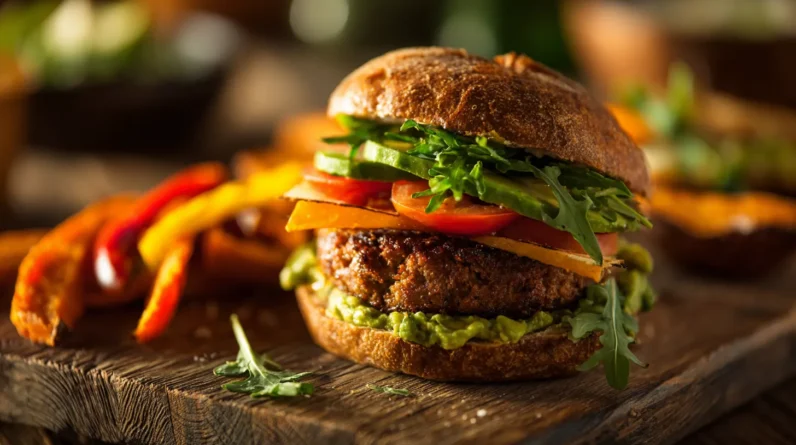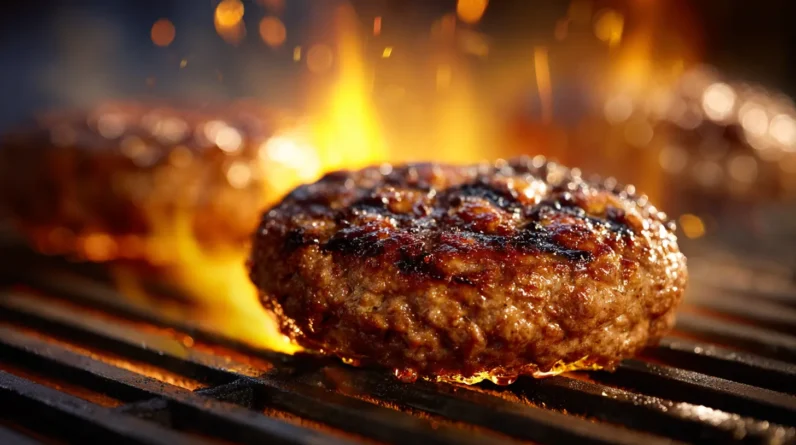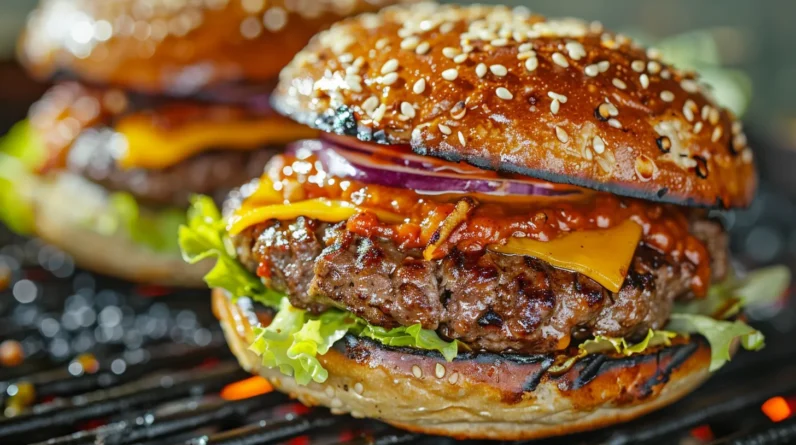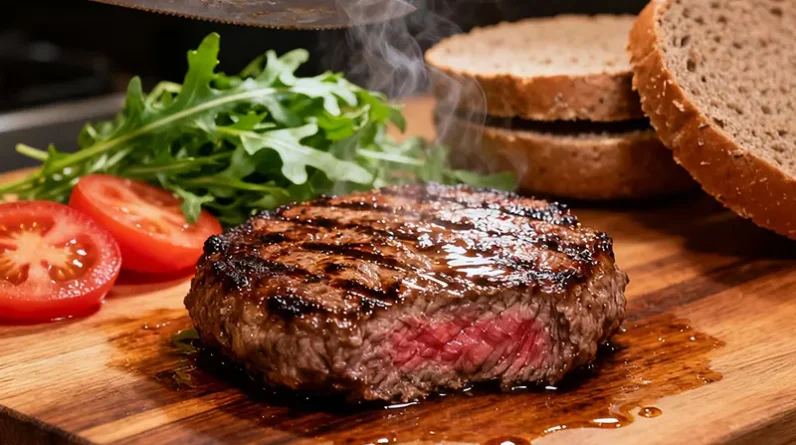
Commercial burger buns contain over 20 chemical additives that trigger inflammatory cascades, while CAFO-raised beef delivers reduced omega-3 concentrations and elevated cortisol levels. We’re also consuming heterocyclic amines and polycyclic aromatic hydrocarbons when high-heat cooking exceeds 300°F. Strategic ingredient swaps like sprouted grain buns, grass-fed beef, and medium-rare preparations can eliminate pro-inflammatory compounds while maximizing micronutrient density. Understanding these specific modifications will transform your burger into a metabolically supportive meal.
The Hidden Health Hazards Lurking in Standard Burger Components
Standard burger components contain multiple nutritional threats that compromise our metabolic health through excessive saturated fat, refined carbohydrates, and sodium concentrations. We’re confronting processed meat patties delivering inflammatory compounds and nitrates, while conventional buns contribute refined flour’s glycemic spikes. Fast food establishments typically utilize trans fats in cooking oils, creating cardiovascular risks through oxidative stress pathways.
Processed cheese adds unnecessary sodium loads, often exceeding 300mg per slice, while condiments introduce high-fructose corn syrup and preservatives. These components collectively trigger insulin resistance mechanisms and inflammatory cascades. We must recognize that traditional burger construction creates nutrient-poor, calorie-dense meals averaging 800-1200 calories with minimal micronutrient density.
Identifying these hazards enables us to develop strategic burger alternatives that maintain palatability while optimizing nutritional profiles through ingredient substitution and preparation methodology modifications.
Processed Buns and Their Chemical Load
The average commercial burger bun contains over 20 chemical additives that disrupt our metabolic processes and compromise digestive health. These preservatives, emulsifiers, and synthetic dough conditioners create inflammatory cascades while depleting beneficial gut microbiota. High-fructose corn syrup and refined flour spike insulin levels, promoting adipogenesis and metabolic dysfunction.
We must prioritize bun alternatives that support ideal physiological function:
- Sprouted grain breads containing activated enzymes and enhanced bioavailability
- Portobello mushroom caps providing umami flavor with minimal glycemic impact
- Cauliflower-based wraps delivering cruciferous compounds and fiber density
Whole grains offer superior nutritional profiles through intact bran and germ components. These provide B-vitamins, magnesium, and prebiotic fibers that support hepatic detoxification pathways. Strategic substitutions eliminate pro-inflammatory additives while maximizing micronutrient density and satiety mechanisms.
The Truth About Conventional Ground Beef Quality
While many consumers assume ground beef provides consistent nutritional value, conventional production methods substantially compromise protein quality and nutrient density. We’re encountering beef sources from concentrated animal feeding operations (CAFOs) where cattle consume grain-based diets rather than their natural grass-fed nutrition. This dietary manipulation reduces omega-3 fatty acid concentrations while increasing inflammatory omega-6 ratios.
Meat labeling regulations don’t require disclosure of these nutritional disparities, leaving consumers uninformed about significant quality variations. Conventional ground beef often contains meat from multiple animals, increasing contamination risks and diluting nutrient profiles. We’re also seeing higher cortisol levels in CAFO-raised cattle due to stress conditions, which negatively impacts meat tenderness and nutritional composition. Understanding these production differences enables us to make informed decisions about our protein sources and overall meal quality.
High-Heat Cooking Methods That Create Toxic Compounds
When we expose ground beef to high-temperature cooking methods above 300°F, we’re triggering the formation of heterocyclic amines (HCAs) and polycyclic aromatic hydrocarbons (PAHs), both classified as probable human carcinogens by the International Agency for Research on Cancer. These toxic compounds develop through amino acid and creatine reactions during high-heat protein cooking, substantially elevating cancer risks.
Grilling, pan-frying, and broiling represent the most problematic cooking methods for toxic formation:
- Direct flame contact creates the highest PAH concentrations
- Cooking times exceeding 4 minutes dramatically increase HCA levels
- Well-done burgers contain 3.5 times more HCAs than medium-rare preparations
Temperature and duration directly correlate with carcinogen concentration. We can minimize these health risks by adopting lower-temperature cooking methods and reducing cooking times while maintaining food safety standards.
Smart Ingredient Swaps for a Nutrient-Dense Burger
Beyond reducing cooking-related toxins, we can dramatically enhance our burger’s nutritional profile through strategic ingredient modifications that boost micronutrient density while maintaining palatability. Replace traditional refined flour buns with whole grains like sprouted wheat or quinoa-based alternatives, increasing fiber content and B-vitamin availability. Incorporate fresh vegetables as primary patty components—finely diced mushrooms, grated zucchini, or minced bell peppers add volume while reducing caloric density and enhancing phytonutrient profiles. Substitute conventional cheese with avocado slices, providing monounsaturated fats and potassium. Consider leafy greens like arugula or spinach instead of iceberg lettuce, delivering folate, vitamin K, and antioxidants. These modifications preserve taste satisfaction while creating a nutrient-dense meal that supports ideal metabolic function and reduces inflammatory burden.
Safer Cooking Techniques That Preserve Flavor
Temperature control emerges as the most critical factor in minimizing harmful compound formation while preserving the Maillard reaction responsible for desirable flavor development. We recommend implementing low temperature cooking methods that reduce heterocyclic amine (HCA) and polycyclic aromatic hydrocarbon (PAH) formation. Gentle grilling at medium-low heat (300-350°F) maintains ideal protein denaturation while preventing excessive charring.
Strategic cooking modifications include:
- Pre-cooking patties partially in the oven before finishing on the grill to reduce total high-heat exposure
- Flipping frequently every 1-2 minutes to guarantee even heat distribution and prevent surface carbonization
- Using marinades containing antioxidant compounds like rosemary extract or citrus acids to inhibit HCA formation
We can achieve superior flavor profiles through controlled thermal processing that prioritizes both palatability and nutritional safety through evidence-based culinary techniques.
Building Your Complete Healthy Burger Meal Plan
Optimized cooking techniques form just one component of a thorough nutritional strategy that requires systematic meal planning to maximize health outcomes. We’ll construct an exhaustive framework that balances macronutrient ratios while addressing micronutrient density across all meal components.
Your burger meal planning should prioritize lean protein-to-fat ratios of 80:20 or higher, paired with complex carbohydrates from whole grain buns. We’ll incorporate fresh produce strategically: antioxidant-rich leafy greens provide folate and vitamin K, while tomatoes deliver lycopene and vitamin C. Consider adding avocado for monounsaturated fats and fiber.
Side dish selection requires equal attention. Replace processed potato products with sweet potato preparations to increase beta-carotene and fiber content. This systematic meal planning approach guarantees the most favorable nutrient bioavailability while maintaining satiety.
Conclusion
We’ve uncovered the metabolic saboteurs hiding in conventional burgers—from inflammatory trans fats in processed buns to heterocyclic amines formed during high-heat grilling. By implementing evidence-based modifications like whole grain alternatives, grass-fed beef, and low-temperature cooking methods, we can transform this American staple into a nutrient-dense meal. The choice isn’t between flavor and health; it’s between informed preparation and biochemical chaos. Our upgraded burger blueprint proves we don’t have to sacrifice taste for ideal nutritional outcomes.


